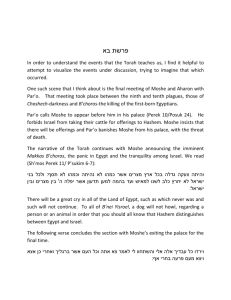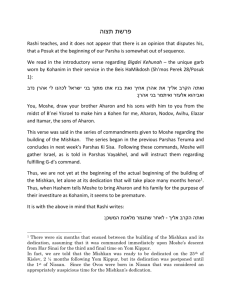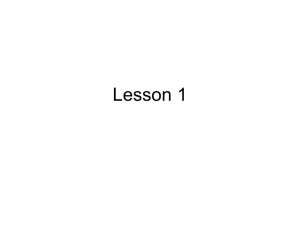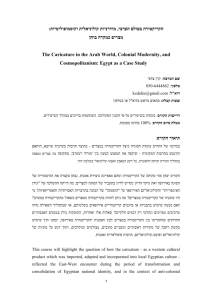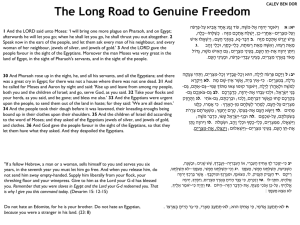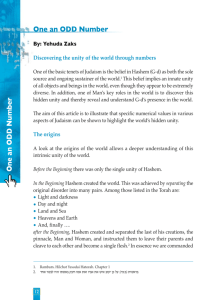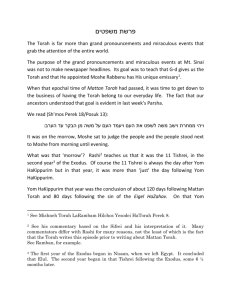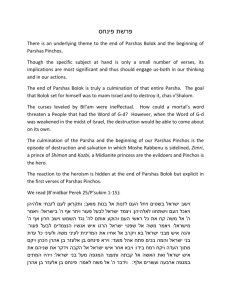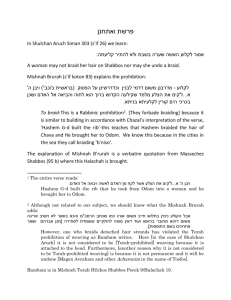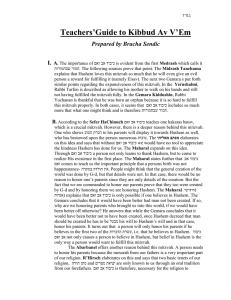Voeira 5774
advertisement
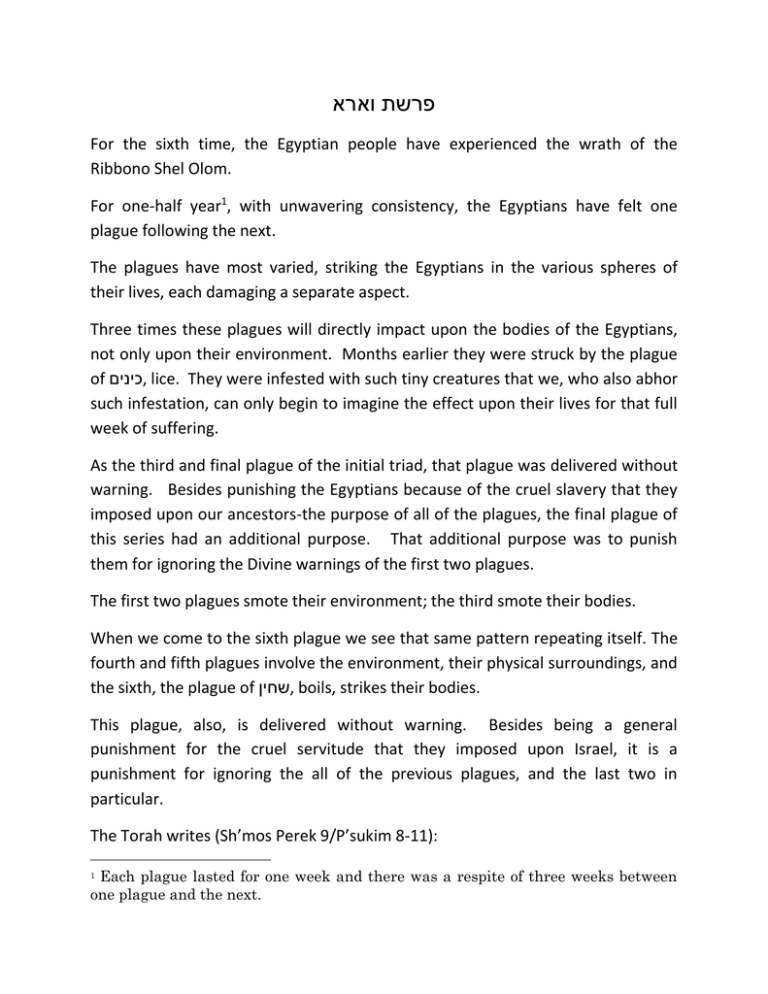
פרשת וארא For the sixth time, the Egyptian people have experienced the wrath of the Ribbono Shel Olom. For one-half year1, with unwavering consistency, the Egyptians have felt one plague following the next. The plagues have most varied, striking the Egyptians in the various spheres of their lives, each damaging a separate aspect. Three times these plagues will directly impact upon the bodies of the Egyptians, not only upon their environment. Months earlier they were struck by the plague of כינים, lice. They were infested with such tiny creatures that we, who also abhor such infestation, can only begin to imagine the effect upon their lives for that full week of suffering. As the third and final plague of the initial triad, that plague was delivered without warning. Besides punishing the Egyptians because of the cruel slavery that they imposed upon our ancestors-the purpose of all of the plagues, the final plague of this series had an additional purpose. That additional purpose was to punish them for ignoring the Divine warnings of the first two plagues. The first two plagues smote their environment; the third smote their bodies. When we come to the sixth plague we see that same pattern repeating itself. The fourth and fifth plagues involve the environment, their physical surroundings, and the sixth, the plague of שחין, boils, strikes their bodies. This plague, also, is delivered without warning. Besides being a general punishment for the cruel servitude that they imposed upon Israel, it is a punishment for ignoring the all of the previous plagues, and the last two in particular. The Torah writes (Sh’mos Perek 9/P’sukim 8-11): Each plague lasted for one week and there was a respite of three weeks between one plague and the next. 1 ויאמר ה' אל משה ואל אהרן קחו לכם מלא חפניכם פיח כבשן וזרקו משה השמימה והיה לאבק על כל ארץ מצרים והיה על־האדם ועל הבהמה לשחין:לעיני פרעה פרח אבעבעת בכל ארץ מצרים ויקחו את פיח הכבשן ויעמדו לפני פרעה ויזרק אתו ולא יכלו החרטמים לעמד:משה השמימה ויהי שחין אבעבעת פרח באדם ובבהמה :לפני משה מפני השחין כי היה השחין בחרטמם ובכל מצרים Hashem said to Moshe and to Aharon, ‘Take for yourselves full of your hands grasping of the soot of the furnaces and Moshe should cast it up to the sky before the eyes of Par’o. It will become dust over the entire land of Egypt and it will be upon man and animal as boils that thrive to be eruptions in all of the Land of Egypt. They took the soot of the furnaces and they stood before Par’o and Moshe cast it skyward and it became boil eruptions that thrived in man and animal. The magicians of Par’o were unable to stand before Moshe because of the boils and the boils were upon the magicians and all of Egypt. There are many unusual phraseologies, and changes in them that draw the attention of the commentators. Certainly, all deserve our attention. We will focus on a particular aspect. Why was it necessary to have furnace soot to bring about the plague? What was the purpose of casting it to the sky and why was that event required to take place before Par’o? We have seen that the third plague, כינים, lice and the sixth plague, שחין, boils parallel one another. Let us examine another parallel. We read regarding the former parallel (Perek 8/P’sukim 12-15) ויאמר ה' אל משה אמר אל אהרן נטה את מטך והך את עפר הארץ והיה לכנם בכל ויעשו כן ויט אהרן את ידו במטהו ויך את עפר הארץ ותהי הכנם באדם:ארץ מצרים ויעשו כן החרטמים בלטיהם:ובבהמה כל עפר הארץ היה כנים בכל ארץ מצרים ויאמרו החרטמם אל פרעה:להוציא את הכנים ולא יכלו ותהי הכנם באדם ובבהמה :'ל'קים הוא ויחזק לב־פרעה ולא שמע אלהם כאשר דבר ה...אצבע א Hashem said to Moshe, “say to Aharon, ‘stretch your staff and smite the dirt of the land and it will become lice in the entire Land of Egypt. They did so; Aharon stretched his hand with his staff and he smote the dirt of the land and it became lice in man and animal; all the dirt of the land became lice in the entire Land of Egypt. The magicians did the same with their sorcery to take out the lice and they were unable; and the lice were in man and animal. The magicians said to Par’o, it is the Finger of G-d and Par’o’s hard hardened and he did not listen to them, as Hashem spoke. Certainly there is a similarity between the plagues of lice and boils in regards to the way in which they were delivered. Let us look at those ways. Lice were delivered by means of the dirt of the earth; boils by furnace soot. Certainly they have much in common. In particular, we could say that both are without value. At first blush, neither is useful; one has little use for either. Isn’t that striking? Bodily punishments are delivered via substances that are taken to be useless. What message were the Egyptians to take from these means of punishment? They were being warned and punished at the same time. Their lives were becoming useless. They were no more valuable than the dust of the earth and the filthy residue of the furnace. But there is more to consider. The dirt of the ground and the soot are not one and the same. The dirt is the ground itself. It does have value. When it is separated from the ground it may have no use. But, as long as it is part of the ground it is inherently worthy of use. On the other hand, soot is just dirt. At one time it had value; it provides heat and warmth. But the aftermath of the burning was of no value whatsoever. As the plagues continued, there was not only an addition in quantity, first there was one not there was two. The quality changed as well. First, the soot was even less valuable than the dirt. If the implication of the medium used for the plague is the symbolism, then the statement meant by the means of the deliverance of the sixth plague is more powerful than the statement meant at the deliverance of the third plague. Egypt is becoming less and less precious before G-d. Their inherent value is decreasing rapidly. There is little loss to be had in smiting them. Furthermore, that increasing weakness is expressed by the ever-shrinking size of the matter which will be used to smite them. When the first of the bodily plagues was delivered, the entire earth was called upon to produce the lice. The earth was hit and from all of it, all of the vermin were brought into being. In the case of the second bodily plague, it was no longer necessary to use an entire substance. A massive handful was sufficient to infect the entire Land of Egypt. In fact, Chazal note the miraculous nature of the event, as Rashi writes. Hashem tells Moshe to cast the soot upwards, towards Heaven. Rashi writes: אחד, הרי נסים הרבה. כל דבר הנזרק בכח אינו נזרק אלא ביד אחת- וזרקו משה ואחד שהלך האבק על כל.שהחזיק קומצו של משה מלא חפנים שלו ושל אהרן :ארץ מצרים And Moshe shall cast it-that which is thrown without power is only thrown with one hand. Behold, there are many miracles hereOne-Moshe’s hand encompassed the double-hand portions of Moshe and Aharon. One-the dirt went upon all of Egypt2. Malbim adds that there was an additional miracle. Soot is practically weightless. It is far lighter than dirt. That which is less weighty cannot be thrown as far as that which is weightier. Nonetheless, this substance affected all of Egypt, thrown as it was, in the cumbersome manner in which it was cast. Of course, this same miracle could have occurred during the plague of כינים-a little amount of dirt could have gone a long way. But, such was not done in the earlier plague. Egypt had not yet strained its relationship with G-d to such a degree that their land should be destroyed. By the time that the months leading towards the sixth plague had elapsed, the relationship was being pulled tauter and tauter. A little soot, without any value at all, was all that it took. A little soot that was cast up awkwardly, with two hands, without force, miraculously spread over all of Egypt. That wonder would not have happened three months earlier. The lives of the Egyptians were more valuable then. However, as their evil increased, by virtue of ignoring the palpable demonstration of Divine Justice, their own personal worth diminished step by step. Until now we have focused on the delivery of this plague. However, we need to focus on the nature of the plague itself. Chizkuni agrees that there is a phenomenon. He writes: דבר זה לא היה מספיק לכל מצרים לפיכך צריך לומר מעצמו בא השחין ולא- מלא חפניכם אלא שאין הקדוש ברוך הוא רוצה לשנות מנהג העולם ועושה כענין במקצת,מתולדות האש .הנוהג 2 A full hands grasp-this amount was not sufficient to bring a plague upon all of Egypt. Thus, we must say that the boils came about ‘on their own’, and not from a fire derivative. [If so, why did Hashem give such an impression with the burning bush? Hashem does not want to change, and thus He acts in such a way that leads to moderate success. שחיןis a boil. It is a sore on the body that is most painful. Because it swells in/on the body, the larger it becomes the more painful that it is. An invasive treatment of boils is done by puncturing. Making a hole in the boil releases the fluid inside and relieves the severe pain that the afflicted individual is experiencing3. What would happen if that boil was impenetrable? The pain would increase enormously, rendering the suffering individual to a state of agony. Thus, the commentators tell us that these boils had two stages4. We read in Masseches Bava Kamma (80 b), and in many Midrashim as well: לח מבחוץ- שחין שהביא הקדוש ברוך הוא על המצרים:אמר רבי יהושע בן לוי . ויהי שחין אבעבועות פורח באדם ובבהמה: שנאמר,ויבש מבפנים Rabi Yehoshua said, “The boils that Hashem brought upon Egypt had fluid on the outside and dry inside, as it says, ‘it became boils, eruptions that flourished in man and in animal. 3 Hopefully, no one will relate to the few words here as practical medical advice. The commentators note the variance in subsequent P’sukim. In Posuk 9 we read: והיה לאבק על כל ארץ מצרים והיה על האדם ועל הבהמה לשחין פרח אבעבעת בכל ארץ :מצרים It will be dirt on the entire Land of Egypt and it will be upon man and animal for a boil, growing, in the entire land of Egypt. 4 In this verse, the order of the words is ‘boil that flourishes eruptions’. In the next Posuk we read: ויקחו את פיח הכבשן ויעמדו לפני פרעה ויזרק אתו משה השמימה ויהי שחין אבעבעת פרח :באדם ובבהמה They took the soot of the furnace and they stood before Par’o and Moshe cast it towards the sky; and it became boils, eruptions that flourished in man and in animal. This change in the order of the words reflects the two stages of the growth of the boils. The boils had fluid parts and dry parts. parts were not. The fluid parts were dynamic; the dry At first, the boils were dry inside and liquidly on the outside. They grew and despite the ability to penetrate the outside layer, the dry boil could not be relieved. When the boil reached its proper size, its nature changed. The inner substance solidified and the outer layer changed to liquid. The outer layer could thus be opened-but since the inner section, the boil itself, was solid, it remained with its full force, nothing could relieve its horrific pain5. When the boils reached their final size, the ailment itself reflected the nature of the Egyptians. Par’o said at times that he was willing to send Israel out of Egypt; but the inside was hard, a refusal that marked the determination of Par’o and the Egyptian People not to bend before G-d. We will consider one final aspect. In each of the first nine plagues, sometimes Moshe or Aharon were the designated enabler and at other times Hashem performed the miracle without human ‘support’. As the Baalei Tosfos point out in the compilation known as Hadar Z’keinim, this second bodily plague was unique. . מכה זו היתה על ידי שלשתן הקדוש ברוך הוא משה ואהרן.וזרקו משה השמימה אהרן סייע לו שמלא חפניו מפיח הכבשן ונתנו ביד משה ומשה זרקו והקדוש ברוך הקדוש.' ובט' מכות כל אחד משלשתן עשה ג.הוא נהג הפיח בכל ארץ מצרים ומשה. ואהרן עשה דם צפרדע כנים.ברוך הוא עשה ברד ארבה חשך מכת בכורות :עשה ערוב דבר שחין Moshe shall cast it to the sky-This plague was done by the three of themHaKodosh Boruch Hu, Moshe and Aharon. Aharon aided Moshe by filling the double – handful from the furnace soot and he placed it into the hand of Moshe and Moshe cast it and Hashem carried it throughout the entire Land of Egypt. In the other nine plagues, each of the three each did three 5 See Malbim here. plagues. Hashem [directly] did the plagues of hail, locusts, and the killing of the firstborn. Aharon did the plagues of blood, frogs and lice and Moshe did the attacks of the wild animals, the animal plague and boils6. What was the message of this second bodily plague that was performed by Hashem with the express participation of Moshe and Aharon? I think that it is expressed by the next-to-the-last verse of the section. We read: ולא יכלו החרטמים לעמד לפני משה מפני השחין כי היה השחין בחרטמם ובכל :מצרים The sorcerers were unable to stand before Moshe because of the boils, because the boils were in the sorcerers and in all of Egypt. Hadar Z’keinim explains: כדכתיב. מפני שמשה היה חשוב בעיניהם.ולא יכלו החרטומים לעמוד לפני משה לכך ולא יכלו. ודרך שחין להיות על הברכים והשוקים.והאיש משה גדול מאד :לעמוד לפניו The sorcerers could not stand before Moshe-This is because Moshe was important in their eyes, as the verse7 says, ‘the man Moshe was very great.’ It is the nature of boils to be on knees and the thighs-thus they could not stand. That is, from the human perspective, the casting of the soot to the sky caused the boils and that action was undertaken by Moshe, with the help of Aharon who provided him with the soot and, of course, by Hashem. 6 The entire Posuk (Sh’mos Perek 11/Posuk3) reads: ויתן ה' את חן העם בעיני מצרים גם האיש משה גדול מאד בארץ מצרים בעיני עבדי פרעה ובעיני :העם Hashem gave the people [Israel] favor in the eyes of Egypt; also the man Moshe was very great in the Land of Egypt, in the eyes of the servants of Par’o and in the eyes of the [Egyptian] people. 7 It must be noted, however, that this verse is written after the plague of darkness, much later than the timeframe of the plague of boils. This verse is difficult if we understand correctly what Hadar Z’keinim writes. If ‘not standing before Moshe’ was a sign of respect for him, why did they need the physical disability caused by the plague. Would it not have been a more forceful event if they were physically able to have stood before Moshe but had chosen not to stand against him? Why was the disability necessary? The answer is clear they were hardened. They could not accept the clear facts that were so readily apparent. They were not willing to subjugate themselves, neither before Moshe nor before the unseen G-d of Israel. Of course, in another quarter of year, they would not have a choice. That which was told to them from the outset8 would be realized. The final bodily plague will be decisive. They will not be injured or be suffused with discomfort and pain; they will die at the direct intervention of Hashem9. What are we to learn from the detail about his plague, and the others, that the Torah provides us in Torah She’b’chsav and Torah She’ba’al Peh? If we observe the events in Egypt some 3326 years ago and are astounded at the barrier that they established that protected them from the obvious truth, then we We read Hashem’s early words to Moshe Rabbenu in Parshas Sh’mos (Perek 4/P’sukim 22-23): 8 ואמר אליך שלח את בני ויעבדני ותמאן לשלחו:ואמרת אל פרעה כה אמר ה' בני בכרי ישראל :הנה אנכי הרג את בנך בכרך You shall say to Par’o, “Thus says Hashem-‘Israel is my first-born son. I will say to you, ‘send out my son and he will serve Me’ and you will refuse to send him; behold I Hashem will kill your first-born son.” Yalkut Shimoni to Parshas Bo (199) brings the famous interpretation that we find in Haggadah Shel Pesach. 9 In Parshas Bo, G-d expresses the impending Makkas B’echoros by emphasizing His direct intervention. He says I will go down to Egypt, I will pass over, I will smite. And the Midrash says that Hashem is telling them: .אני ולא מלאך אני ולא שרף אני ה' אני ולא אחר I, and not an angel, I, and not a seraph, I Hashem, I and no one else. have to ask ourselves as well-are there obvious signs in the world that we live in that we ignore? Do we attend to the punishments that are visited upon the world, upon Israel and upon ourselves? Do we acknowledge the goodness that comes to the world, to Israel and to us personally? Have we developed callousness, either from inside or on the outside that prevents us from acknowledging in a true way that which we know is true, even if the truth is inconvenient? As always, it is a mistake to learn the Torah as a historical reader. Instead, we must remember to see Torah as being alive, vibrant, relative to us in all aspects of our being. We must make sure that we are not modern day Egyptians who will only realize the truth and act upon it when it is too late. Next week, in Parshas Bo, we will read of the physical redemption of Israel and in three weeks’ time we will read of the spiritual redemption of Mattan Torah. Let us not be bystanders! Let us join the flow of history and again seek that Divine redemption in all of its parts. Shabbat Shalom Rabbi Pollock
